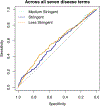A fully-automated event-based variant prioritizing solution to the CAGI5 intellectual disability gene panel challenge
- PMID: 31066479
- PMCID: PMC6744322
- DOI: 10.1002/humu.23781
A fully-automated event-based variant prioritizing solution to the CAGI5 intellectual disability gene panel challenge
Abstract
Recent applications of gene panel sequencing analysis have significantly helped with identifying genetic causes for inherited diseases. However, large amounts of candidate variants remain a major challenge for prioritizing, often requiring arbitrary cutoffs in multiple steps. In addition, existing tools often prioritize a list of promising candidates that require much manual work to evaluate. To this end, we designed an automated, basically cutoff-free scoring scheme named Context and Hereditary Event based Scoring Scheme (CHESS), that scores all possible inheritance events in each gene, by taking into consideration phenotypes, genotypes, and how the manual prioritization works. We applied CHESS to the Critical Assessment of Genome Interpretation 5 intellectual disability panel challenge, to assign clinical phenotypes to patients based on gene panel sequencing data. Through this blind testing, CHESS proved to be a leading and useful tool for genetic diagnosis in a research setting. Further analyses showed that precise phenotype terms played an important role in variant prioritization and that multiple etiologies may exist for some patients. CHESS also successfully identified many of the causal, putative and contributing variants. In the postchallenge analysis, we showed that our best submission performed slightly better than the predictions made by a state-of-the-art tool. We believe that CHESS can provide aid to this and many other diagnostic scenarios.
Keywords: gene panel sequencing; genetic diagnosis; intellectual disability; variant prioritization.
© 2019 Wiley Periodicals, Inc.
Conflict of interest statement
CONFLICT OF INTERESTS
The author declares that there is no conflict of interests.
Figures




References
Publication types
MeSH terms
Grants and funding
- ZHANGJIANG Lab, Shanghai/International
- California Initiative for Advancing Precision Medicine/International
- 2018SHZDZX01/Shanghai Municipal Science and Technology Major Project/International
- 91530321/National Natural Science Foundation of China/International
- gift/Jeffrey Modell Foundation/International
- R13 HG006650/HG/NHGRI NIH HHS/United States
- U41 HG007346/HG/NHGRI NIH HHS/United States
- 61572363/National Natural Science Foundation of China/International
- NIH U41 HG007346/NH/NIH HHS/United States
- 61772368/National Natural Science Foundation of China/International
- NIH R13 HG006650/NH/NIH HHS/United States
LinkOut - more resources
Full Text Sources

